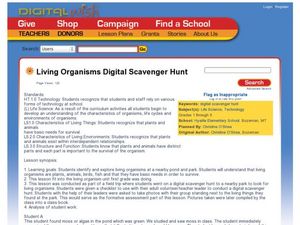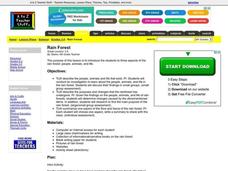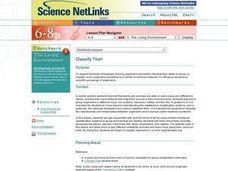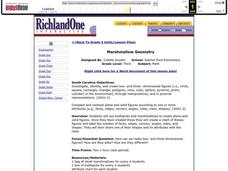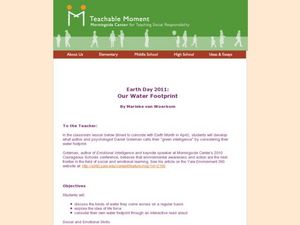Curated OER
Living Organisms Digital Scavenger Hunt
Students photograph living organisms. In this plan for a field trip, students go to a local park or pond and photograph themselves with various living organisms on their scavenger hunt list. The photographs taken are compiled into a...
Curated OER
Classify That!
Students get acquainted with diverse forms of life by using modern biological classification systems to group animals that are related. They explore basic scientific groupings like genus, species, mammals, fish, birds, amphibians, and...
Curated OER
Identify the Three Economic Sectors
Learners identify the three economic sectors found in the United States. They organize different foundations into these three categories. They examine why each sector is necessary in our society.
Curated OER
Rain Forest
Students discover three aspects of the rain forest. They describe the people, animals, and vegetation in the rain forest. They identify the changes the rain forest has gone through and the reasons behind the changes. They choose one...
Curated OER
Texture: Wild Things
Students experiment with different kinds of marking techniques. They read "Where the Wild Things Are" and observe animals for pattern and line. They compare illustrations with Haring's images. They create a symbolic drawing of animal.
Curated OER
Character and Citizenship Education
Young scholars identify two or three specific actions he or she can accomplish to practice good citizenship.They research and agree to accomplish one social health action before the end of the week
Curated OER
Classify That!
Young scholars explore diverse forms of life by using modern biological classification systems to group animals that are related. Students then study basic scientific groupings like genus, species, mammals, fish, birds, amphibians, and...
Curated OER
Marshmallow Geometry
Third graders create 2D and 3D shapes using marshmallows and toothpicks. In this geometry lesson, 3rd graders create their shapes and document the number of faces, edges, corners, angles, and sides. They share one shape and its...
Curated OER
Which One Matters?
Students study the balance necessary to maintain ecosystems and how changing that balance can impact the ecosystem. They identify and discuss the need for balance in any ecosystem and discuss how greenhouse gases impact ecosystems.
Curated OER
Organ System Interactions
Eighth graders who have studied all of the organ systems now discover how they all are related and work together in the human body. They discuss a variety of situations in which more than one system plays a part. They identify the...
Curated OER
Discussion Questions for Amber Bechtel's Essay on AIDS in South Africa
Pupils read an essay by Amber Bechtel on the situation of AIDS in South Africa. After reading, they participate in a class discussion answering questions posed by their teacher. To end the lesson plan, they reflect on the situation in...
Curated OER
That's Not a Noun! Worksheet 2
For this nouns and verbs worksheet, students analyze a word bank with 12 words that are commonly used as verbs, but can be nouns. Students read 12 sentences and select the correct word to complete each.
Curated OER
Aspects of Individual Human Blood Pressure
Learners learn about human blood pressure. In this biology lesson plan, students gain an understanding of the relationship between hypertension and it's risk factors, demonstrate how pressure builds up in clogged arteries, and measure...
Curated OER
Making Something from Nothing
Students explore how to make something out of nothing. In this recycling lesson plan, students discuss the importance of recycling and what effects their choices could have on future generations. Students create something new out of...
Curated OER
Shackleton's Antarctic Adventure
Students research the exploration of Antarctica by the explorer Sir Ernest Shackelton. In this Antarctic exploration instructional activity, students watch a movie about Sir Ernest Shackelton and his ship the Endurance. Students study a...
Curated OER
Polar Expeditions
Students consider the implication of polar exploration. In this polar exploration lesson plan, students research the expeditions that Admiral Peary, Dr. Cook, Captain Scott, and Roald Amundsen made to the North and South Poles. Students...
Curated OER
Food Webs
Students research an animal to define its food web and life cycle. In this animal life cycle instructional activity, students research an animal and define its food web. Students then present their animal food webs to the class and note...
Curated OER
Looking and Learning in the Art Museum
Pupils analyze art in a museum and write an essay about the responsibilities of museum professionals. In this museum and art lesson, students identify the roles of an art museum. Pupils evaluate the ability of a museum to fulfill its own...
Curated OER
The World of Insects and Spiders
Students identify numerous insects and their body parts. In this insect life lesson, students practice using scientific vocabulary while comparing the different parts of spiders and insects. Students view several videos...
Curated OER
You Are What You Eat: Plastics and Marine Life
Students study the different types of plastics and see which ones sink or remain buoyant. In this ocean environmental lesson students complete several handouts, and view a film on PBS.
Curated OER
Kitty Tunes
Students compare cat calls. In this wildlife lesson, students listen to cat calls and compose their own raps that feature the calls of Florida panthers.
Curated OER
Our Water Footprint
Students discuss the water usage of the world and their own water usage. In this water lesson plan, students read a story about water and discuss different statistics of water usage around the world.
Curated OER
National Worm Survey
Students participate in the National Worm Survey. In this National Worm Survey lesson, students generate data on earthworms. Students submit their data to the online database Worm Watch.
Curated OER
Parts of a Plant
Students explore biology by listening to an in-class lecture. In this plant science lesson, students sing songs with their classmates regarding anatomical parts of a plant and create plants from arts and crafts materials. Students listen...


